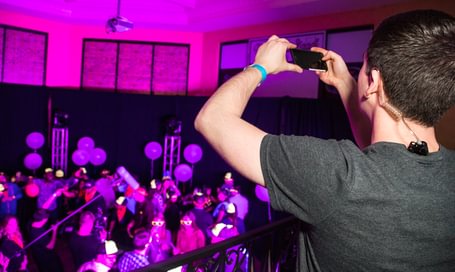A Case for Embracing AI in Video Production

It’s undeniable that the creative AI revolution is at our doorstep.
It's an evolution rapidly permeating every aspect of our lives, from business processes to creative endeavors.
But the pivotal question remains: Do we embrace it or stand wary?
When the topic comes up, it’s easy to see why there’s a divide. Will AI take creatives’ jobs away from them? Will it replace journeymen writers?
Content is springing up across the web, written by AI and used unironically by creators and businesses alike.
How does that make you feel?
Intrigued?
Overwhelmed?
AI: The Creative Conundrum
The past decade has seen AI transition from a tool for complex computational tasks to an assistant that aids creativity. AI isn't just here for problem-solving; it's redefining how we create.
Some view AI as a friend, an ally that can handle mundane tasks, while others see it as an adversary, a threat to originality and human touch. For many, it's a handy assistant, providing a middle ground.
And the truth is AI's presence is complex. It writes blogs, generates creative content like video scripts, crafts ad copies, and customizes social media posts. It's an expansive toolkit for modern creators.
It’s easy to use it incorrectly and create garbage.
It’s hard to use it productively and make magic.
So, will you opt for the easy route and contribute to the piles of bad creative in the years to come?
Or will you learn the craft of AI and leverage it as a powerful tool to enhance your abilities?
Or maybe something else entirely?
Reimagining Video Production with AI
Take video production, for example. AI enables the creative process while simplifying more foundational tasks.
• ChatGPT, the most well-known large language model AI, assists video creators in refining scripts, brainstorming titles, and even streamlining the nitty-gritty of video production, like schedules and budgets.
• Midjourney is a fun tool for generating images based on text and image prompts. Want to imagine your storyboard or assemble a treatment? It’s a different way to get inspired and play.
• Topaz Video Enhancer makes upscaling blurry or pixelated footage high-end. Different AI models are helping to clean up facial blemishes, scale animation, improve stabilization, adjust frame rates, and much more.
• Adobe Enhance makes it easy to clean up audio files. While it’s not quite perfect, you can take poorly recorded audio with a lot of background noise and get close to studio quality in an instant. The catch? It might sound a bit robotic.
• Loom is a great video communication tool with new features that leverage AI. It automatically drafts your video's header, sets chapter markers, and curates a succinct description. Such features reduce the burden of mundane tasks and let creators focus on what truly matters: the content.
There are scarier tools that allow you to leverage AI voices and actors, but… some tools really need some additional questioning before they’re widely deployed.
To Embrace or To Resist?
As AI surges ahead, reshaping the contours of video production and beyond, the ball is in our court.
Do we run from it, or do we harness its immense potential?
In embracing AI, we don't just adopt a tool; we welcome a new way of thinking, a novel approach to creation. It offers efficiency, sure, but it also presents an opportunity to break the mold, to innovate.
But like every tool, it's about how we use it. AI can complement human creativity, not replace it.
It can take over repetitive tasks, but the soul, the essence of creation, remains inherently human.
AI in video production isn't a fleeting trend.
Instead, it's a paradigm shift. And as creators, entrepreneurs, and innovators, it’s on us to decide how we navigate this brave new world. Will we embrace the change or resist it?
The choice, as always, is ours.
Here’s a solid approach for considering AI (in 2023):
• Deploy it for back-end tasks that you don’t love. For example, how can AI help you manage your projects, tackle bookkeeping, and create chapters in your video?
• Give it a go in areas where you can’t afford a professional, but want improvements. For example, how can it help your audio mix or your footage quality?
• Need a little boost and additional options. For example, writing headlines, looking for tag lines, considering alternative lines, and generating storyboard ideas.
If you liked this post, give it a share.

